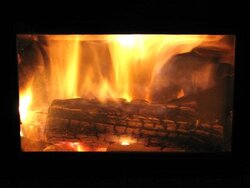My frustruation over extemely short burns continues. I'm hoping you guys can help me out. I've posted a picture with this thread showing my stove's version of a lazy burn. I have the air completely shut in this picture and still have a healthy, racing yellow flame coming up dead center. I know these newer stoves aren't supposed to allow for a smolder, but this seems extreme to me.
To date, my longest burn time is 90 minutes. I've tried different types and sizes of wood, various air levels, etc. I've been burning wood for over 20 years. I have never had a stove that I had to tend to this much. It's driving me nuts.
I have checked the seals on both doors, and both are excellent. The dollar bill is impossible to pull out of either. I stuck it in the ash pan door this morning, and while it is more than snug from above, it does come out easily if I close it from below. I don't know if that's a clue. The underside of the stove clicks a lot when the stove is heating up. I'm not sure if that's normal since I've never had one with an ash pan. I lit a stick of incense and held it near the ash pan door as well as the other doors. In no case did the smoke track toward the stove. It pulled to the right constantly, but that might just be how it burns. If it is something related to the ash pan door, it makes me nervous that it will warp if I keep using it as is.
Is there any other ways I can check for unwanted air infiltration? I'm am so lost at this point and starting to not enjoy my new stove. The only constant seems to be that the healthy flame is always dead center. Most of you know my setup. Single wall pipe to thimble, the 18' of exterior chimney, 1 90 degree elbow involved. With just minimal chimney height, is it even possible that this is overdraft due to chimney? Can anyone point me in the right direction?
thanks
To date, my longest burn time is 90 minutes. I've tried different types and sizes of wood, various air levels, etc. I've been burning wood for over 20 years. I have never had a stove that I had to tend to this much. It's driving me nuts.
I have checked the seals on both doors, and both are excellent. The dollar bill is impossible to pull out of either. I stuck it in the ash pan door this morning, and while it is more than snug from above, it does come out easily if I close it from below. I don't know if that's a clue. The underside of the stove clicks a lot when the stove is heating up. I'm not sure if that's normal since I've never had one with an ash pan. I lit a stick of incense and held it near the ash pan door as well as the other doors. In no case did the smoke track toward the stove. It pulled to the right constantly, but that might just be how it burns. If it is something related to the ash pan door, it makes me nervous that it will warp if I keep using it as is.
Is there any other ways I can check for unwanted air infiltration? I'm am so lost at this point and starting to not enjoy my new stove. The only constant seems to be that the healthy flame is always dead center. Most of you know my setup. Single wall pipe to thimble, the 18' of exterior chimney, 1 90 degree elbow involved. With just minimal chimney height, is it even possible that this is overdraft due to chimney? Can anyone point me in the right direction?
thanks


